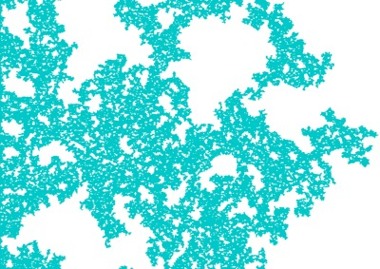We tend to think of losing consciousness as an abrupt shutting down of our awareness of the world, like flicking a light switch. But it’s actually more of a gradual process. The best way to understand it is to brew a cup of coffee.
A new theoretical model described in Physical Review Letters suggests that the loss of consciousness that occurs under anesthesia looks a lot like how water seeps through coffee grounds, at least mathematically speaking. Those findings could help shed light on precisely how changes in brain activity can lead to the loss and re-emergence of consciousness.
First, let’s clarify what we mean by “consciousness.” There’s a difference between wakefulness/basic self-awareness – what philosopher Ned Block has termed “access consciousness” — and so-called “phenomenal consciousness,” relating to higher cognitive functions like how we experience the colour red, for instance, or our emotions. The mystery behind the latter — how a distinct, persistent, thinking and feeling human identity arises from a bunch of brain cells — is a tough nut to crack. It’s so tough it’s known as the “hard problem” of consciousness.
But neuroscience has learned a great deal about the former in recent years, at least in broad strokes. The brain is a vast, complex network of networks. There are several regions, each with billions of individual neurons that constantly form connections, through which signals (information) can flow. There are lots of local connections and a few key long-range connections linking the local regions to Central Processing (i.e., the cerebral cortex).
That constant flow of information between interlinked neurons across a complex network is what gives rise to consciousness. That makes consciousness an emergent property, rather than something more fundamental. Think of it like this: A lump of gold has properties like hardness, or colour, or temperature, but they are not found in any one of the individual atoms that make up said lump at the fundamental level. No, they “emerge” from all the connections between those atoms.
The neurons in the brain work much the same way. The various brain regions are constantly collecting and processing incoming signals — even when we’re under anesthesia — but “we” are not aware of those signals until they are sent to the cortex and integrated together to produce conscious experience. So the emergence of consciousness appears to be related to the integration of information across large networks.
That’s the big picture, anyway, but the details remain pretty fuzzy as to how this happens. Researchers at the University of Pittsburgh School of Medicine wondered whether patients losing consciousness under the influence of anesthesia might be the result of reduced connectivity in the neural network, which hampers that all-important flow of sensory information. So they devised a mathematical model to test that hypothesis based on the physics of percolation. And it turns out they might be onto something.
Percolation is a way of modelling network connectivity via a type of phase transition. It’s a slow continuous process much like water moves through fresh ground coffee beans. Per an article I wrote for Quanta article in July:
Traditional mathematical models of percolation, which date back to the 1940s, view the process as a smooth, continuous transition. “We think of percolation as water flowing through the ground,” said Robert Ziff, a physicist at the University of Michigan who has been studying phase transitions for the past 30 years. “It’s a formation of long-range connectivity in the system.”
The formation of connectivity can be understood as a phase transition, the process whereby water freezes into ice or boils away into vapour. Phase transitions are ubiquitous in nature, and they also provide a handy model for how individual nodes in a random network gradually link together, one by one, via short-range connections over time. When the number of connections reaches a critical threshold, a phase shift causes the largest cluster of nodes to grow rapidly, and über-connectivity results. (Seen this way, the percolation process that gives rise to your morning cup of joe is an example of a phase transition. Hot water passes through roasted beans and shifts into a new state — coffee.)

Falling asleep or waking up from anesthesia seems to follow a similar trajectory. All those tiny interactions between neurons build up until a critical point is reached, at which point the brain enters an entirely new state, moving from unconsciousness to consciousness. (Specifically, the brain waves switch to the gamma and beta waves associated with consciousness from alpha waves related to drowsiness, and the delta waves that accompany deep sleep.)
Yan Xu and several colleagues at the University of Pittsburgh’s School of Medicine built a computer model to explore the dynamics of such a system. Imagine each neuron as a node in a network, arranged in a tree-shaped network. Sensor signals pass into the trunk and then spread outward to the various branches in the network.
It’s the nodes that decide which signals will be passed along, and which ones will be killed. Each node adds up all the signals it gets from the other nodes directly connected to it, and the sum of those signals is then passed on — or not. When hot water seeps through packed coffee grains, it searches for the most viable path. The more connected routes that are open, the better the chances it will filter through. Information flow between neurons is also enhanced by having lots of connected through-roads. Anesthesia seems to cut off many of those routes, until there just isn’t sufficient connectivity left for signals to travel beyond local brain regions. Information doesn’t filter through.
Xu et al calculated the probability of a signal reaching the outermost branches and found that the flow of information in their simulated model, with just 7381 nodes, meshes nicely with the brain activity observed in experimental studies of patients under the influence of anesthesia. For instance, a 2011 study found that as the anesthesia took effect, brain regions that normally communicated and coordinated with each other fell out of sync: the network connections went offline. There were still basic signals registering with the sensory cortex — the auditory region continued to respond to outside noise, for instance — but there was no long-range communication with that all-important cerebral cortex. So the signals never spread beyond local brain regions. That severing of connection didn’t happen when the study participants were awake, or only mildly sedated.
Of course, this is a highly simplified model. “The brain is many orders of magnitude more complex,” Xu et al. write in their paper, with billions of node-like neurons, not just a few thousand. We’re a long way off from a complete explanation of the underlying mechanisms behind consciousness. But it’s one more useful clue to add to pile as neuroscientists build their case.
Just something to think about the next time you’re brewing your morning cup of joe….
[Via Physical Review Letters]
Image via Cuba Coffees.
References:
Alkire M.T., Hudetz A.G., Tononi G. (2008) “Consciousness and Anesthesia,” Science 322: 876-880.
Brown, E.N., Lydic, R., and Schiff, N.D. (2010) “General Anesthesia, Sleep, and Coma,” New England Journal of Medicine 363: 2638-2650.
Lewis, Laura D. et al. (2012) “Rapid Fragmentation of Neuronal Networks at the Onset of Propofol-Induced Unconsciousness,” Proceedings of the National Academy of Sciences 109(49): E3377 — E3386.
Tononi, Giuli. (2008) “Consciousness as Integrated Information: A Provisional Manifesto,” Biological Bulletin 215: 216-242.
Zhou, D.W. et al. (2015) “Percolation model of sensory transmission and loss of consciousness under general anesthesia,” Physical Review Letters 115: 108103.
